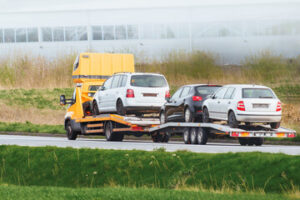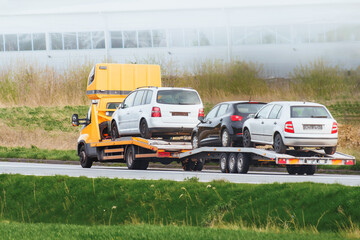If you’re like most light-duty pickup truck owners, you use your vehicle to haul a trailer to work or play. But towing is about more than power – it requires attention to details and maintenance for your suspension, brakes and braking system, engine, transmission, axle ratio and more.
Overloading your Phoenix Towing capacity can damage your truck’s frame, transmission and braking systems. It can also lead to costly mechanical failures and dangerous driving conditions.
Brakes are one of the most important things to keep in mind when towing. The additional weight of the trailer can overpower a tow vehicle’s brake system and cause dangerous situations. Adding or upgrading your trailer’s braking system can help reduce brake wear, improve stopping power and prevent swaying.
Towing-specific brake systems are a must for anyone that regularly hauls a heavy load. Many trailer brakes come stock with a break-away system that can be activated in case of an emergency. Some states have laws requiring this feature on any trailer over a certain weight or type.
There are two main types of trailer braking systems: surge brakes and electric trailer brakes. Surge brakes, commonly found on smaller boat trailers and rental trailers, leverage the difference in momentum between your tow vehicle and trailer. When you slow down or stop your truck, that difference in momentum pushes against the trailer’s hitch and tongue, compressing an air bladder which then activates the trailer brakes.
Electric trailer brakes use a control unit to sense when your tow vehicle’s brake-lamp circuit is on and then trigger the trailer brakes. These systems offer more precise control and are typically less expensive than a surge brake system. They can be more complex to install, however. Some require lengthy installations into both the towing vehicle and the trailer. Others are more portable (like a BrakeBuddy) and only need to be inserted and removed each time you tow.
The best trailer braking systems use a time-delayed controller to trigger the trailer brakes at a rate proportional to your vehicle’s braking force. This gives the driver the opportunity to slam on the brake pedal and still have enough braking force left to pull a trailer without risking an accident or excessive wear on the towed vehicle’s brakes.
The quality of your rotors is also an important factor in determining how well your brakes perform. Opt for rotors that are mill-balanced to ensure an even distribution of weight over the entire surface, reducing vibration and noise and extending their lifespan. Also, choose a rotor material that can reduce heat to prevent brake fade when towing for prolonged periods of time.
Tires
Racers are laser-focused on their race car’s performance, but there are other important components of a race operation that can get overlooked. The tires on the tow vehicle and trailer are one of these, as they are a major factor in towing and must be properly sized for the intended load.
The towing capacity of a tire is indicated by its load index and load range, which are listed on the sidewall. The higher the number, the greater the weight-carrying capacity. A good general rule of thumb is to go with a higher load index than the tires that came stock on your truck, but make sure you consult your manufacturer’s recommendations, which can be found on the driver’s door placard or in your owner’s manual.
In general, heavier tires are better for towing because they are designed to withstand higher loads and have rigid sidewalls that prevent them from deforming under pressure. This increases their ability to handle the additional load of a trailer and its contents, as well as the added weight of the truck itself and passengers in the cab.
Towing tires should also have a tread pattern that performs well in mud, light snow, and rain. Look for tires that are rated for all-season use or have specific features to help with different weather conditions, such as circumferential grooves or a large tread block count.
Lastly, make sure your towing tires are inflated to the maximum recommended pressure, which can be found on the manufacturer’s placard or in your owner’s manual. Overinflated tires can reduce the load-carrying capability and increase rolling resistance, which will decrease your fuel economy and make it harder for your tow vehicle to accelerate and brake safely.
If you’re looking to upgrade your tires for towing, Les Schwab carries a variety of P (passenger), LT (light truck), and HT (highway) tires in all-terrain, highway, and all-season tread patterns. If you need help determining the right size and type of tires for your truck, our team of tire experts is here to assist. We can even give your trailer tires a visual inspection and add air for you for free.
Tire Pressure
A tire’s pressure can change when it is loaded, but the best way to know is by checking the pressure with a quality tire gauge. This can be purchased at a local auto parts store for $10 to $20. The gauge uses mechanical methods to measure pressure based on the movement of a piston or diaphragm, which is displayed on a dial or in a digital display. Dial and pen-type gauges are popular for their durability and portability. Checking your tires’ pressure should be done regularly, and preferably before each trip. A good tire pressure gauge should be accurate to within 2% or less, and it is essential that the readings are taken when the tires are cold. An increased reading, typically 2 to 6 psi higher than the recommended pressure, is normal as the tire warms up.
Many people ask what the optimum tire pressure is for towing, and the answer is it depends on many factors. The placard on the driver’s door jamb indicates a maximum vehicle load pressure, but this isn’t a good guide to optimal pressures for different speeds or loads. It’s much more important to follow the vehicle manufacturer’s recommended tire pressure, which can be found in the owner’s manual or on the driver’s door jamb.
The recommended pressures are based on the vehicle’s size and weight, tire size and type, and towing capacity. The recommended psi is the air pressure at which the tire can safely carry its maximum load. The tire manufacturers have designed the tires and certified them to meet specific load capacities based on their design, construction and materials.
Changing the tire pressures can affect handling and fuel economy, and can also cause uneven wear of the tread, which is why it’s important to rotate the tires at regular intervals. You should also be careful when using public air pumps and compressors, as they may not be properly maintained or regulated. If you are unsure of what the proper tire pressure is for your vehicle, consult a mechanic. It is very dangerous to drive with improperly inflated tires.
Hitch
A hitch is an extra piece of equipment that attaches to the back of a vehicle, allowing it to draw a trailer. Trailer hitches are available in different load classes and the class system helps drivers know if their towing gear is up to the task. There are also additional towing components that are needed to complete a towing system like a draw bar, hitch ball and pin.
The five different types of tow hitches include:
Receiver Hitch
The most common trailer hitch is a receiver-type that mounts on the rear of a vehicle and has an opening for a removable aftermarket hitch-mounted accessory like a bike rack or cargo carrier. This type of trailer hitch has a maximum towing capacity of 3,500 pounds and can be used with most mid-sized cars, minivans and small pickup trucks. If you’re planning to tow heavier loads with a standard receiver hitch, consider upgrading to a weld-on hitch that can be bolted to the frame of your truck.
Weld-on hitches have a much higher towing capacity than standard receiver hitches and can be used with larger pickup trucks, dually trucks and chassis cabs. They can be used with campers, small car haulers and flatbed equipment trailers.
A fifth-wheel coupling (also called a kingpin hitch) is designed to couple with the specialized lunette ring of a fifth-wheel trailer. It’s similar to the gooseneck hitch but mounts in the middle of a pickup truck bed, which makes it less restrictive than a gooseneck when it comes to turning radius.
A gooseneck hitch is another heavy-duty option that has a smaller neck and coupler connection to tow more significant loads, like large cargo trailers or even semi-trailers. This style of hitch mounts at the front of a pickup truck and can be used with livestock, flatbed equipment or even a car trailer. Whether you’re looking for a basic ball mount or a loaded one that already has a trailer ball pre-torqued or welded to it, O’Reilly Auto Parts carries the receiver hitch and accessories you need. A safety chain is a must-have for every towing setup as it keeps the trailer from falling off the towing vehicle and potentially hurting someone.
